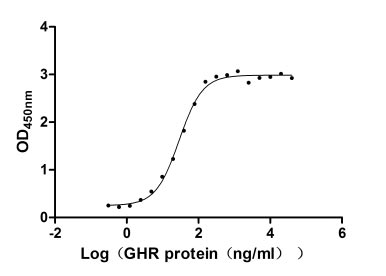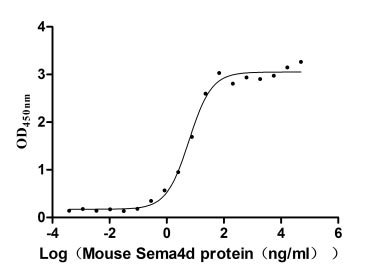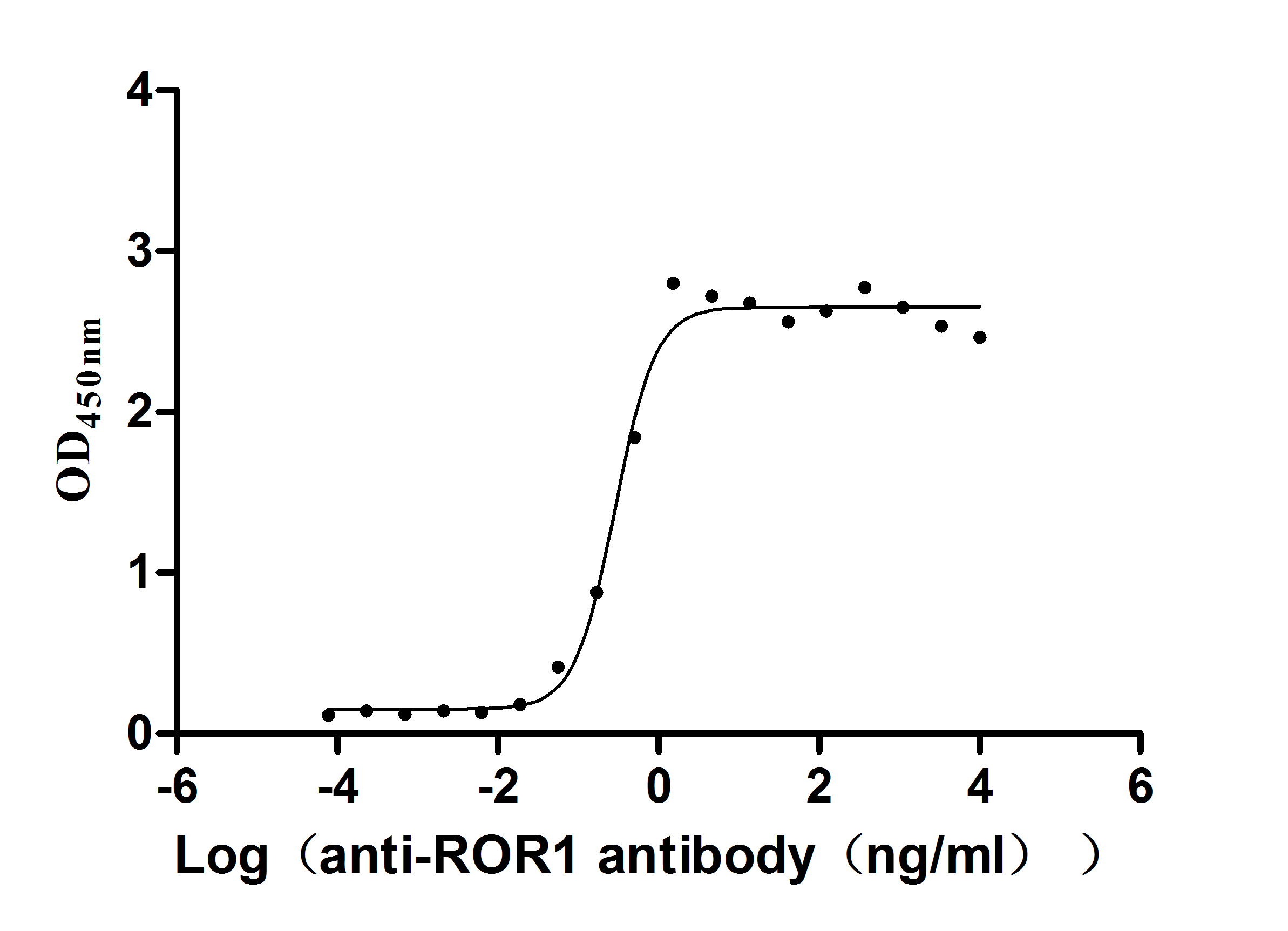Recombinant Drosophila melanogaster Homeotic protein bicoid (bcd)
-
中文名称:Recombinant Drosophila melanogaster Homeotic protein bicoid(bcd),Yeast
-
货号:CSB-YP362587DLU
-
规格:
-
来源:Yeast
-
其他:
-
中文名称:Recombinant Drosophila melanogaster Homeotic protein bicoid(bcd),Yeast
-
货号:CSB-EP362587DLU
-
规格:
-
来源:E.coli
-
其他:
-
中文名称:Recombinant Drosophila melanogaster Homeotic protein bicoid(bcd),Yeast
-
货号:CSB-EP362587DLU-B
-
规格:
-
来源:E.coli
-
共轭:Avi-tag Biotinylated
E. coli biotin ligase (BirA) is highly specific in covalently attaching biotin to the 15 amino acid AviTag peptide. This recombinant protein was biotinylated in vivo by AviTag-BirA technology, which method is BriA catalyzes amide linkage between the biotin and the specific lysine of the AviTag.
-
其他:
-
中文名称:Recombinant Drosophila melanogaster Homeotic protein bicoid(bcd),Yeast
-
货号:CSB-BP362587DLU
-
规格:
-
来源:Baculovirus
-
其他:
-
中文名称:Recombinant Drosophila melanogaster Homeotic protein bicoid(bcd),Yeast
-
货号:CSB-MP362587DLU
-
规格:
-
来源:Mammalian cell
-
其他:
产品详情
-
纯度:>85% (SDS-PAGE)
-
基因名:bcd
-
Uniprot No.:
-
别名:bcd; CG1034Homeotic protein bicoid; PRD-4
-
种属:Drosophila melanogaster (Fruit fly)
-
蛋白长度:full length protein
-
表达区域:1-494
-
氨基酸序列MAQPPPDQNF YHHPLPHTHT HPHPHSHPHP HSHPHPHHQH PQLQLPPQFR NPFDLLFDER TGAINYNYIR PYLPNQMPKP DVFPSEELPD SLVMRRPRRT RTTFTSSQIA ELEQHFLQGR YLTAPRLADL SAKLALGTAQ VKIWFKNRRR RHKIQSDQHK DQSYEGMPLS PGMKQSDGDP PSLQTLSLGG GATPNALTPS PTPSTPTAHM TEHYSESFNA YYNYNGGHNH AQANRHMHMQ YPSGGGPGPG STNVNGGQFF QQQQVHNHQQ QLHHQGNHVP HQMQQQQQQA QQQQYHHFDF QQKQASACRV LVKDEPEADY NFNSSYYMRS GMSGATASAS AVARGAASPG SEVYEPLTPK NDESPSLCGI GIGGPCAIAV GETEAADDMD DGTSKKTTLQ ILEPLKGLDK SCDDGSSDDM STGIRALAGT GNRGAAFAKF GKPSPPQGPQ PPLGMGGVAM GESNQYQCTM DTIMQAYNPH RNAAGNSQFA YCFN
-
蛋白标签:Tag type will be determined during the manufacturing process.
The tag type will be determined during production process. If you have specified tag type, please tell us and we will develop the specified tag preferentially. -
产品提供形式:Lyophilized powder
Note: We will preferentially ship the format that we have in stock, however, if you have any special requirement for the format, please remark your requirement when placing the order, we will prepare according to your demand. -
复溶:We recommend that this vial be briefly centrifuged prior to opening to bring the contents to the bottom. Please reconstitute protein in deionized sterile water to a concentration of 0.1-1.0 mg/mL.We recommend to add 5-50% of glycerol (final concentration) and aliquot for long-term storage at -20℃/-80℃. Our default final concentration of glycerol is 50%. Customers could use it as reference.
-
储存条件:Store at -20°C/-80°C upon receipt, aliquoting is necessary for mutiple use. Avoid repeated freeze-thaw cycles.
-
保质期:The shelf life is related to many factors, storage state, buffer ingredients, storage temperature and the stability of the protein itself.
Generally, the shelf life of liquid form is 6 months at -20°C/-80°C. The shelf life of lyophilized form is 12 months at -20°C/-80°C. -
货期:Delivery time may differ from different purchasing way or location, please kindly consult your local distributors for specific delivery time.Note: All of our proteins are default shipped with normal blue ice packs, if you request to ship with dry ice, please communicate with us in advance and extra fees will be charged.
-
注意事项:Repeated freezing and thawing is not recommended. Store working aliquots at 4°C for up to one week.
-
Datasheet :Please contact us to get it.
靶点详情
-
功能:Segment polarity protein that provides positional cues for the development of head and thoracic segments. Regulates the expression of zygotic genes, possibly through its homeodomain, and inhibits the activity of other maternal gene products. May also bind RNA. Interacts with Bin1 to repress transcription of bicoid target genes in the anterior tip of the embryo; a process known as retraction.
-
基因功能参考文献:
- NMR methodology was employed for determining the dynamics of lysine side-chain amino groups via (15)N relaxation measurements in the Lys50-class homeodomains from the Drosophila protein Bicoid and the human protein Pitx2 PMID: 29664630
- These data support a model where Bcd influences chromatin structure to gain access to concentration-sensitive targets at high concentrations, while concentration-insensitive targets are found in more accessible chromatin and are bound at low concentrations. PMID: 28891464
- The s find that Bicoid transcriptional activity is dispensable for embryonic viability in the first hour after fertilization, but persistently required throughout the rest of the blastoderm stage. Short interruptions of Bicoid activity alter the most anterior cell fate decisions, while prolonged inactivation expands patterning defects from anterior to posterior. PMID: 28691901
- Vinblastine treatment allowed the simulation of an ideal SDD model whereby the protein moved throughout the embryo in a broad front. In unfertilized embryos, the Bcd protein followed the mRNA which itself was transported into the interior of the embryo utilizing a hitherto undiscovered microtubular network PMID: 28973031
- The Bcd gradient is observed in embryos that express a Bicoid-eGFP fusion protein (Bcd-GFP) which cannot differentiate if Bcd is freely diffusing or bound to immobile sites. This work analyzes an SDID model that includes the Interaction of Bcd with binding sites. PMID: 28054512
- The present study examines the effect of advection transport on the formation of the Bicoid morphogen gradient using direct simulation of the cytoplasmic streaming. PMID: 27193268
- results have important implications for how Bcd recognizes its different targets to mediate its critical developmental functions PMID: 28547993
- biophysical model in which Bcd diffuses and interacts with binding sites to show that both FRAP and FCS estimates may be correct and compatible with the observed timescale of gradient formation in establishment of the anterior-posterior embryonic axis PMID: 24901638
- Bicoid mRNA counts are highly reproducible between embryos to within ~9%, matching the reproducibility of the protein gradient. Changing the genetic dosage in the female leads to proportional changes in both mRNA and protein numbers in the embryo. PMID: 24856210
- Studies indicate that Bicoid (Bcd), is expressed from anteriorly distributed mRNAand forms a decreasing concentration gradient from the anteriorto posterior of the embryo. PMID: 25016297
- This study proposes that the establishment of the hunchback pattern relies on Bicoid-dependent lengthening of transcriptional activity periods in the anterior half of the embryo, and may require two distinct repression mechanisms in the posterior. PMID: 24139736
- this study documents, for the first time, a case of within-species Bcd scaling achieved through adjusting the gradient profile's exponential shape characteristic, illustrating at a molecular level how a developmental system can follow distinct operational paths towards the goal of robust and scaled patterning. PMID: 24284208
- Cic acts on Bcd dependent enhancer elements by repression and thereby controls the posterior limit of Bcd target gene expression. PMID: 20404518
- Bcd concentration at target gene expression boundaries is nearly unchanged early in development but adjusts dynamically as development progresses. PMID: 23580621
- The SUMO moiety has an intrinsic inhibitory activity for the activator function of Drosophila Bcd protein. PMID: 22584054
- Study analyzed 66 Bcd-dependent regulatory elements and show that their boundaries are positioned primarily by repressive gradients that antagonize Bcd-mediated activation. PMID: 22541432
- Parameter estimation on models by spatio-temporal Bicoid profiles suggests strong support for regulated stability over either a constant supply rate or one where the maternal mRNA is permitted to degrade in a passive manner. PMID: 21949782
- Bcd production rate, which is dependent on the total number of bcd mRNA molecules in the anterior, is scaled with embryo volume. PMID: 21613328
- Study represents a first experimental uncovering of the actions of Bcd in controlling the actual transcriptional events while its positional information is decoded during development. PMID: 21544208
- The formation of the Bicoid morphogen gradient requires protein movement from anteriorly localized mRNA. PMID: 21390295
- The question of Bcd mobility was investigated using fluorescence correlation spectroscopy in live Drosophila melanogaster embryos. PMID: 20712981
- The positional precision provided by the Drosophila morphogenetic protein Bicoid (Bcd) in wild-type (wt) embryos with embryos lacking an interacting cofactor, was compared. PMID: 20682246
- Results suggest that the ventral splay of segmentation genes along the A-P axis may be directly traced to the distinct properties of the Bcd gradient on the dorsal and ventral sides of the embryo. PMID: 20678215
- Deletion of a short sequence in Bicoid impairs its nuclear accumulation. This effect is due to a approximately 4-fold decrease in nuclear import rate and a approximately 2-fold reduction in nuclear residence time compared with the wild-type protein. PMID: 20699297
- Bicoid provides dose-dependent positional information along the axis, maternal Hunchback is required for the synchrony of the response and is therefore likely to be involved in this memorization process. PMID: 20663819
- The precision of Bcd target genes for embryos with a single, double or quadruple dose of bicoid demonstrating that precision is highest at mid-embryo and position dependent, rather than gene dependent, is presented. PMID: 20212523
- The data helping to understand how anterior patterning is achieved under the control of Bicoid and challenges for future studies are reviewed [review] PMID: 20219179
- activating and repressive effects of Bcd and Cic, respectively, are integrated by the Bcd target gene enhancer PMID: 19959668
- The activity of the Drosophila morphogenetic protein Bicoid is inhibited by a domain located outside its homeodomain. PMID: 11923203
- the amino-terminal domain of Bcd is an enhancer-specific switch that contributes to the protein's ability to activate different target genes in distinct manners PMID: 12808087
- bicoid mutation enhances the A4 defect of dsp1 PMID: 12820172
- study suggests that the activity of Bcd is intricately controlled by multiple mechanisms involving the actions of co-repressor proteins PMID: 12939280
- Dimerization of bcd mRNA was shown to be important for the formation of ribonucleoprotein particles and their localization in Drosophila embryo. The cis-element responsible for dimerization is localized in a stem-loop domain. PMID: 14607826
- dCBP is an enhancer-dependent co-activator of Bcd, facilitating its activation through multiple mechanisms PMID: 15358774
- in labral regions of the head, Bicoid is converted from an activator into a repressor by recruitment of a co-repressor to Bicoid-dependent promoters PMID: 15649476
- REVIEW: key features of bcd function in Drosophila PMID: 16108065
- bicoid mutants were used to test the importance of cooperative DNA binding by the Bicoid protein in establishing a pattern along the anterior-posterior axis of the early Drosophila embryo PMID: 16150708
- Bcd drives precise and sharp expression of its target genes through a process that depends exclusively on its ability to activate transcription. PMID: 16271865
- the accelerated rate of evolution observed for bcd is owing, at least partly, to variation generated by relaxed selective constraint PMID: 16299585
- Results describe the solution structure of the homeodomain of the Drosophila morphogenic protein Bicoid (Bcd) complexed with a TAATCC DNA site. PMID: 16406070
- The association of bicoid with the anterior oocyte cortex is dynamic and support a model for maintenance of bicoid localization by continual active transport on microtubules. PMID: 16890164
- VPS36 functions by binding directly and specifically to stem-loop V of the bicoid 3' UTR through its amino-terminal GLUE domain, making it the first example of a sequence-specific RNA-binding protein that recognizes the bicoid localization signal PMID: 17268469
- Results describe the development and stability of the Bicoid morphogen gradient in Drosophila embryos that express a Bicoid-eGFP fusion protein. PMID: 17632061
- Results describe measures of precision for the Bicoid morphogen in the Drosophila embryo, and show that the system exerts precise control over absolute concentrations and responds reliably to small concentration differences. PMID: 17632062
- Shape of the Drosophila, Lucilia and Calliphora Bicoid gradients appears to be a conserved feature of the Bicoid protein. PMID: 18328473
- bcd mRNA shifts from continuous active transport to stable actin-dependent anchoring at the end of oogenesis. PMID: 18639459
- Quantitative studies of the bcd gradient are described. PMID: 18854140
- bcd mRNA and Bcd protein gradient profiles are virtually identical at all times. PMID: 19168676
- including trapping and release of Bicoid by the nuclei during cleavage cycles does not alter the morphogen length scale; the inclusion of advective transport due to cytoplasmic streaming can have a large effect. PMID: 19190186
- Target gene positioning involves combinatorial interactions that are mediated by the binding site architecture of each gene's cis-regulatory elements. PMID: 19237583
显示更多
收起更多
-
亚细胞定位:Nucleus.
-
蛋白家族:Paired homeobox family, Bicoid subfamily
-
组织特异性:Maternal expression is an anterior cap concentrated in the cortical cytoplasm.
-
数据库链接:
KEGG: dme:Dmel_CG1034
STRING: 7227.FBpp0081168
UniGene: Dm.3237
Most popular with customers
-
Recombinant Human Growth hormone receptor (GHR), partial (Active)
Express system: Mammalian cell
Species: Homo sapiens (Human)
-
Recombinant Mouse Semaphorin-4D (Sema4d), partial (Active)
Express system: Mammalian cell
Species: Mus musculus (Mouse)
-
Express system: Mammalian cell
Species: Homo sapiens (Human)
-
Recombinant Human Angiopoietin-2 (ANGPT2) (Active)
Express system: Mammalian cell
Species: Homo sapiens (Human)
-
Recombinant Human Intestinal-type alkaline phosphatase (ALPI) (Active)
Express system: Mammalian cell
Species: Homo sapiens (Human)
-
Recombinant Rat Intestinal-type alkaline phosphatase 1 (Alpi) (Active)
Express system: Mammalian cell
Species: Rattus norvegicus (Rat)
-
Recombinant Human V-set and immunoglobulin domain-containing protein 4 (VSIG4), partial (Active)
Express system: Mammalian cell
Species: Homo sapiens (Human)
-
Recombinant Human Tumor-associated calcium signal transducer 2 (TACSTD2), partial (Active)
Express system: Mammalian cell
Species: Homo sapiens (Human)





-AC1.jpg)













